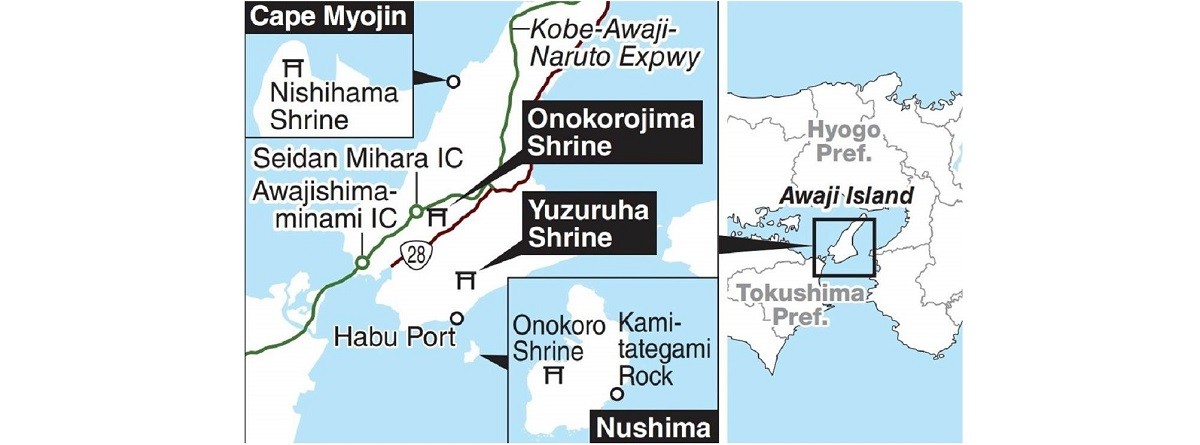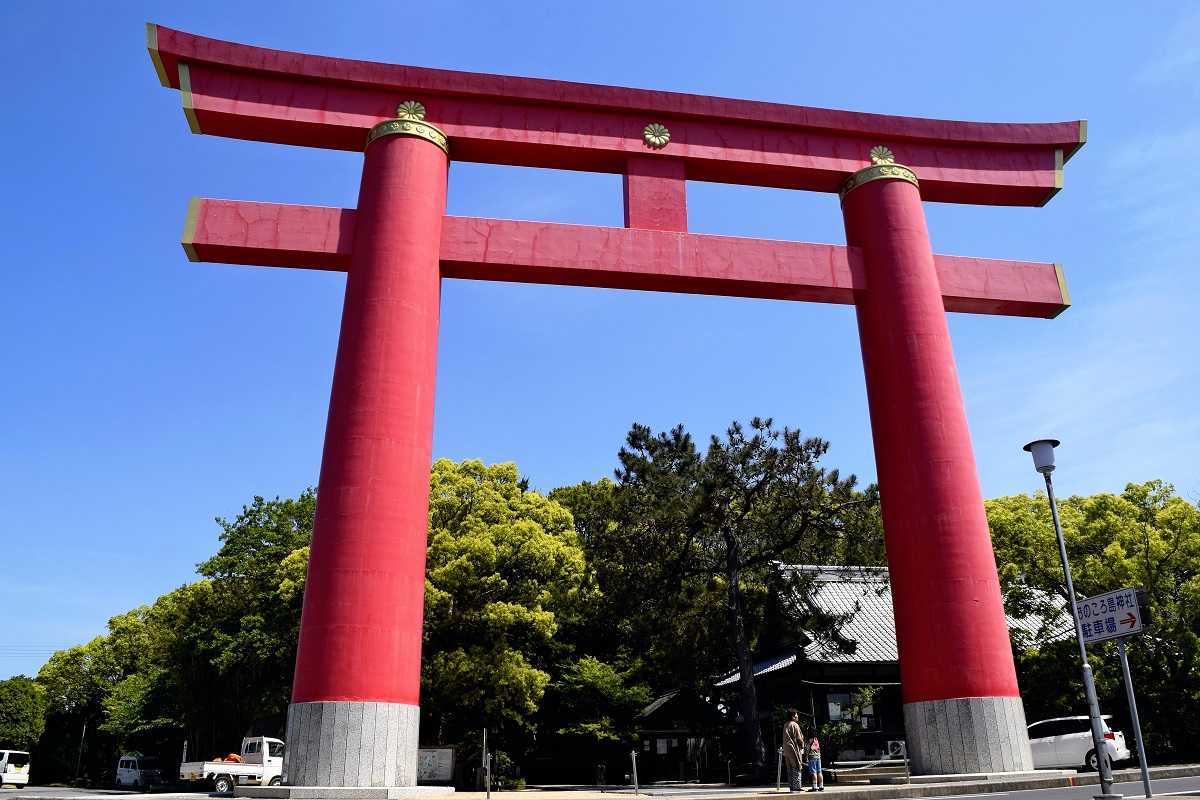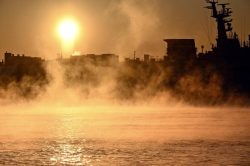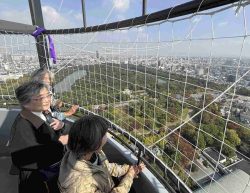
Statues of Izanagi, left, and Izanami at Onokoro Shrine on Nushima Island
12:20 JST, June 24, 2023
MINAMI-AWAJI, Hyogo — In ancient Japanese mythology, the Japanese archipelago was created by two deities named Izanagi and Izanami. Awaji Island in Hyogo Prefecture is said to be the first isle in the archipelago created by the couple. The island is home to many places associated with the myth of Japan’s creation, and some of them are known as photo spots rich in mystery.

As the story goes, after Izanagi and Izanami stirred the sea with a large spear, the seawater dripped down from the spear tip and congealed into an island called Onokoro. The two deities then landed on this island where they married and subsequently created the other islands of the Japanese archipelago, starting with Awaji Island.
Located 4.6 kilometers off the southern coast of Awaji Island, Nushima Island is one of the places suggested as the “real” Onokoro Island. With a perimeter of 10 kilometers, Nushima is home to Onokoro Shrine, which is dedicated to the deity couple, allowing visitors to revel in the world of myth.
Following a 10-minute boat ride from Habu Port in Minami-Awaji, Hyogo Prefecture, a walk of about 30 minutes takes visitors to the top of a small mountain. From the top of the mountain, a huge rock jutting from the sea comes into sight. Kamitategami Rock is about 30 meters high.

Kamitategami Rock juts from the sea on Nushima Island in Minami-Awaji, Hyogo Prefecture.
Izanagi and Izanami are said to have married by circling around a sacred pillar that supports the heavens. Kamitategami Rock is conjectured to be this pillar, or the spear with which the couple churned the sea. It is a formidable sight to behold.
Nushima is overlooked by Mt. Yuzuruha, on which sits a shrine near the 608-meter-high summit, the highest peak on Awaji Island. The shrine is also associated with the two deities. Yuzuruha Shrine is known as a place of ascetic training, but in recent years, many fans of figure skating star Yuzuru Hanyu have visited to cheer him on, as the sound of his name closely resembles that of the shrine’s.
However, getting to the shrine is not easy as the roads leading up to it are steep. Visitors have to drive on a series of mountain roads that can barely accommodate a single car, while some sections of the roads are not even paved. Despite this, Hanyu fans make the difficult trip from across the nation, demonstrating the true depth of their support. Last year, when the Beijing Winter Olympics were held, some 500 wooden votive tablets, or ema, were offered up at the shrine. Recently, an increasing number of people visiting the shrine have prayed for their own success, such as in improved athletic performance, rather than for Hanyu’s.
Awaji Island is also home to another candidate for Onokoro Island. This is the land around Onokorojima Shrine in Minami-Awaji, which enshrines Izanagi and Izanami.

The torii gate of Onokorojima Shrine in Minami-Awaji is known as one of Japan’s three great torii gates.
With its 21.7-meter-high vermilion torii gate, the shrine is known as having one of Japan’s three great torii gates, along with those for Heian Jingu Shrine in Kyoto and Itsukushima Shrine in Miyajima, Hiroshima Prefecture. Onokoro Island is said to have been the hill on which this Onokorojima Shrine sits.
The shrine is said to aid those wishing to get married or for an easy childbirth. On ema tablets dedicated at the shrine, visitors have written wishes such as “May I get a cool boyfriend” and “May I be blessed with a new life.”
It is said that if people hold the red and white ropes tied to the shrine’s “wagtail rock,” they will have a romantic encounter or strengthen their personal relationships. Naturally, it’s a fun spot for couples.
Gigantic rock ‘channels spirits’
Nishihama Shrine, yet another holy place enshrining the creator couple, is situated on the west coast of Awaji City, which is itself located on the northern part of Awaji Island.

A tourist passes through a crevice in a giant rock in Awaji City.
Following the road along the coast from the shrine, one arrives at Cape Myojin’s gigantic rock, which is well-known among enthusiasts of such things as a spot coursing with “spiritual energy.”
Within this rock, there is a narrow vertical crevice that is barely wide enough for one person to pass through, creating a sort of open-ended cave. According to the chief priest of the shrine, the crevice represents a birth canal.
“By going through it, people can reset their mind. Many people find it comforting, so they visit repeatedly,” the priest said.
If you come at the right time of day and year, you can watch the sun set over the coastline through this crevice.
Standing in front of such a rock, one feels a sense of the divine. If nothing else, it possesses a strange power to attract people.
Related Tags
"Features" POPULAR ARTICLE
-

Sanrio to Open Museum in Yamanashi Pref. Dedicated to Founder, Exhibits Include Hello Kitty, Other Characters
-

Autumn Foliage Surrounds Visitors to Tokyo’s Showa Kinen Park
-

My Daughter No Longer Speaks to Me, But I Want to See Her and My Grandchild
-

Kumamoto: Public Bath Refurbished as Library Where You Can Chat, Take Photos
-

Frozen Vegetables: Demand Rises for Convenient, Tasty Domestic Produce
JN ACCESS RANKING
-

Keidanren Chairman Yoshinobu Tsutsui Visits Kashiwazaki-Kariwa Nuclear Power Plant; Inspects New Emergency Safety System
-

Imports of Rare Earths from China Facing Delays, May Be Caused by Deterioration of Japan-China Relations
-

University of Tokyo Professor Discusses Japanese Economic Security in Interview Ahead of Forum
-

Tokyo Economic Security Forum to Hold Inaugural Meeting Amid Tense Global Environment
-

Japan Pulls out of Vietnam Nuclear Project, Complicating Hanoi’s Power Plans
























